Frequently Asked Questions - FAQ
General
No. XC Therm is a so-called Progressive Web App (PWA). This means XC Therm runs directly in the browser, but can also be saved to the smartphone's home screen just like an app and then behaves just like an app from the App Store or Google Play.
The ICON-D2 wind and weather forecasts from XC Therm can be integrated into any website via iFrame. A detailed guide can be downloaded here.
For technical reasons, however, the thermal forecasts cannot be integrated into other websites.
The philosophy of XC Therm is to provide pilots with all the necessary tools so that they can make their own decisions. For this reason, XC Therm does not provide explicit wind or foehn warnings, nor recommendations on which area to fly in.
With the user-friendly high-resolution thermal, wind, and weather forecasts, pilots can get an overview themselves and, based on their own flying skills, determine which area is best for them.
To collect feedback on XC Therm in a central place, there is a forum for all XC Therm users.
As this forum is independent of the regular website, a separate login is required. Every new forum participant must be activated by an admin after registration to ensure the quality of the forum (spam, bots, etc.).
Visit the forum at forum.xctherm.com.
Subscriptions
You can change your subscription yourself. In the map, go to "Settings - Subscription - Manage subscription - Update subscription" and select the desired subscription. If you have a promotion code, you can redeem it there. More information can be found here.
If a subscription is upgraded during its term, the existing subscription will be converted to the larger one. The unused portion of the old subscription cost will be deducted from the new subscription cost. The selected payment method will automatically be charged with the difference. The new subscription is then valid for the remaining subscription period, so the upgrade is effective immediately.
Please note that upgrading to a larger subscription is possible at any time, while downgrading to a smaller subscription can only be done at the time of renewal.
You have received a promotion code (gift voucher or group discount) and want to redeem it? Please proceed as follows:
Case 1: You do not have an active subscription yet
Register at XC Therm and confirm your email address. Then select a subscription on the subscription page.
- On the payment page, select "Add promo code" and enter your promotion code.
- Click the "Apply" button to apply the code.
- The price will be adjusted automatically and you can proceed with the payment.
If your payment fails and the window no longer shows the reduced price, do not continue. The promotion code must then be manually added by us again. Please send us an email at with the promotion code.
Case 2: You have an active subscription and want to upgrade to a larger subscription
In the map, go to "Settings - Subscription - Manage subscription - Update subscription" and select the subscription of your choice. Then follow the instructions as in Case 1.
Case 3: You want to use your promotion code for the automatic renewal of your subscription
- Send an email to with the promotion code.
- We will add the promotion code to your account, it will then be valid for 12 months.
- When your subscription is renewed, the promotion code will be automatically applied.
Important: Promotion codes cannot be redeemed retroactively, so you must enter the promotion code before paying or renewing your subscription.
You can enable or disable the automatic renewal of your subscription yourself. In the map, go to "Settings - Subscription - Manage subscription - Cancel subscription".
The renewal of your subscription will be deactivated, but you can continue to use XC Therm as usual until the current subscription expires. If you later decide to enable automatic renewal again, you can do so at any time.
Our standard payment methods are credit card and PayPal. After payment, the subscription is automatically activated.
It is also possible to pay by bank transfer / prepayment. More information can be found here.
If you want to pay with TWINT or other instant payment methods (Apple Pay, Google Pay, EPS, Sofort, Cartes Bancaires ...) you can find more information here.
Please proceed as follows:
- Transfer the exact amount to our account (account details below).
- Send an email to with the name of the subscription and account holder, the desired subscription, and possibly the promotion code.
- We will activate your subscription, and the term will begin with activation.
EURO account
Account holder: XC Therm GmbH
IBAN: BE54 9671 6197 4097
BIC: TRWIBEB1XXX
Bank address: Avenue Louise 54, Room S52, Brussels, 1050, Belgium
CHF account
Account holder: XC Therm GmbH
IBAN: CH18 0900 0000 6168 5473 5
TWINT, Apple Pay, Google Pay, EPS, Sofort, Cartes Bancaires do not support recurring payments and therefore cannot be used for direct subscription purchases. Please proceed as follows:
Yes, we offer discounts on annual subscriptions for groups of 10 or more people. These group discount offers are valid for one calendar year.
If you are a member of a club or association with an active XC Therm group discount offer, contact your club's board to receive a personal promotion code. Here you can find information on how to redeem it.
If you want to activate a new group discount offer for your club or association, you will find all the information you need here.
The amount of the group discount depends on the number of subscriptions (annual subscriptions) sold within a calendar year (see table below). At the beginning of the year, the group discount offer is set based on the actual annual subscriptions completed in the previous year. Newly registered groups start in the first year with the lowest discount level (10%), provided it can be credibly demonstrated that at least 10 annual subscriptions with the group discount will be concluded. Each member is free to choose which subscription to take.
To start a new group discount offer for your club or association, the following steps are necessary:
- The board of the club or association contacts us at and informs us that they want to start a group discount offer.
- We send the board of the club or association a list of promotion codes.
- The board is then responsible for distributing the promotion codes to the members.
- Each member can receive their personal promotion code from the board and redeem it themselves. More information can be found here.
A collective account for all members is not possible. Each club member needs their own subscription.
We offer monthly and annual subscriptions. If you want to test XC Therm, a monthly subscription is a good choice. To find out whether the Regio or Pro subscription is sufficient for you, or whether you are better off with the Unlimited or Expert subscription, we recommend taking a look at the region overview map.
The following tables also provide an overview of the number of regions per country. Note that regions that are only partially located in a country are also counted for that country. Border regions have therefore been counted twice in these tables.
You should select all regions at the beginning, as adding regions later counts towards the 6 possible changes in the Regio and Pro subscription.
If you have already misunderstood this and have used up your changes at the beginning, please send us an email at . We will reset the counter for possible changes for you once.
Thermal Forecasts
The Potential Flight Distance (PFD) is the distance in km that, according to Regtherm thermal forecasts, can theoretically be covered within a day. The potential flight distance is the core of the thermal overview map of XC Therm and is visualized for each region by color and with the km value.
The PFD is intended to provide a quick overview of the day's potential: At a glance, you can see which regions offer the best cross-country conditions on that day. With the help of the PFD, you can also easily compare the quality of several days.
Note: The potential flight distance is an automated calculation based on the parameters described below and should give an indication of thermal quality. However, a high number of kilometers should not be equated with a flight recommendation. The detailed thermal forecasts for each region and the high-resolution wind forecasts should always be included in flight planning.
The following meteorological parameters are taken into account for each 30-minute interval when calculating the potential flight distance:
Working height
The working height corresponds to the thickness of the layer in which continuous lift is expected. If cumulus clouds are present, the usable height is equal to the cloud base.
If this layer is too thin, we cannot glide to the next thermal and valley crossings become impossible. If the working height is less than 900 meters for a 30-minute interval, no kilometers are added to the total potential flight distance for this interval.
Climb rates
The climb rates determine whether and how quickly altitude can be gained and have a major influence on the potential flight distance.
If the average climb rates over the entire working height are less than 0.8 m/s for a 30-minute interval, no kilometers are added to the total potential flight distance for this interval.
Wind
The influence of wind on a flight is, as is well known, not easy to describe. Depending on the planned flight task (see next question), the wind can lengthen, shorten, or even completely prevent a cross-country flight.
When calculating the PFD for out-and-return flights, stronger wind reduces the PFD, as it slows us pilots down when flying against the wind.
Depending on the selected aircraft, a maximum wind threshold has been defined, above which no kilometers are added in the respective half hour.
Example paraglider:
If the wind at flight altitude is stronger than 30 km/h, it is too strong for most paraglider pilots to do an out-and-return flight.
For gliders, the wind threshold is higher, as they are less sensitive to strong wind than, for example, paragliders.
In contrast to wind speed, wind direction is not taken into account in the PFD calculation. Consequently, the PFD estimates do not take into account foehn winds, which can be dangerous and make flights impossible.
The following configurable parameters are also taken into account:
Aircraft
The polar curve of an aircraft determines the effective glide ratio and thus how many meters can be covered per meter of altitude. High-performance aircraft can therefore fly in stronger winds and need thermals less frequently to continue.
At XC Therm, you can choose between the polar curves of paragliders, hang gliders, rigid wings, and various classes of gliders. In TopTask, you can fine-tune even further by setting the exact polar curve and wing loading of your aircraft.
Pilot level
The pilot level is a percentage factor that is applied to the calculated potential flight distance. This allows a pilot to adapt the calculation of the potential flight distance to their abilities.
Especially for the pilot level, we recommend setting it once and then not changing it, as otherwise the potential flight distance will constantly change and the comparability of the forecasts will suffer.
Flight task
XC Therm supports the flight tasks Return and Oneway. Here you will find a detailed explanation of what these flight tasks mean and how they affect the potential flight distance.
The following parameters are not taken into account:
Foehn
Foehn winds can be dangerous and make flights impossible, depending on the aircraft and pilot skills. As foehn winds can vary greatly by region (direction, channels, danger spots), they cannot be taken into account in the PFD calculation.
Foehn can now be reliably identified on our high-resolution wind forecasts. In addition to the thermal forecasts, these should always be included in flight planning.
Valley winds
Valley winds and the large-scale Alpine pumping are especially known among paraglider pilots for ending cross-country flights early. First, these thermal compensation flows in the lower layers of the atmosphere lead to stabilization. Second, valley winds above a certain speed can disrupt thermals near the ground and lead to strong turbulence. In contrast, the dynamic updrafts of valley winds can also be used to extend a flight.
These are small-scale effects that can vary greatly within a region. As the PFD summarizes the thermal conditions of a region, these effects cannot be taken into account in the PFD calculation.
Precipitation
Flying in rain, snow, or thunderstorms can lead to dangerous situations for many reasons. As the PFD summarizes the conditions of a region, it may happen that precipitation falls in one part of the region while the thermal conditions are ideal in another part. For this reason, PFD values are not reduced if precipitation is forecast in the region.
Return means that you want to return to the starting point. The Return-PFD simulates an outbound flight with tailwind and a return flight with headwind. The stronger the wind, the more difficult this becomes, as at least one leg must be flown against the wind. If the wind is too strong, the potential flight distance is 0 km.
Oneway means that the whole day is always flown with the wind at your back, as is often the case in flatlands. With little wind, the potential flight distance differs only slightly from Return. However, the stronger the wind, the greater the potential flight distance. With the Oneway setting, unrealistically large distances can be calculated in strong winds, so the Oneway PFD should always be used with caution. Therefore, this feature is disabled by default.
Yes, for the thermal climb rates, the sink rate is already subtracted. This means that with the selected aircraft, you climb at the specified speed.
The primary focus of the Regtherm thermal forecasts is on predicting thermal quality. The wind values shown in the detailed forecast are only indicative. However, since these wind values come from a single grid point of the ICON model, they are by far not sufficient for detailed flight planning in the mountains.
Example: The region Urner Alps extends from the Gotthard Pass to the Lake Lucerne, and from the Brünig Pass to the Klausen Pass. This corresponds to a radius of over 60 km. The grid point from which the wind values originate is located roughly in the middle at the southern Lake Lucerne. While the region is drawn so that the thermal conditions are considered homogeneous, the wind values can vary greatly within the region.
For this reason, XC Therm offers high-resolution wind forecasts. These should always be included in flight planning.
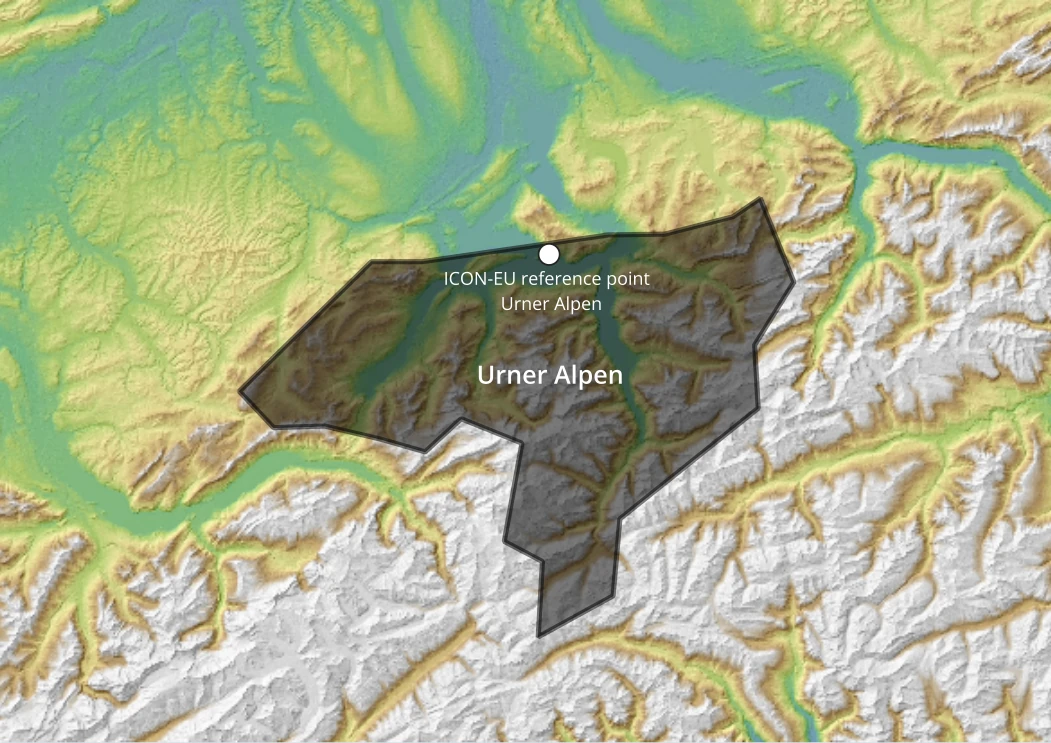
Yes, the thermal forecasts are available retrospectively back to December 6, 2012 for subscribers in the archive. Regardless of your subscription, you can view all regions and days in the archive. Displayed is always the last forecast for the respective day.
The archive data for the period 06.12.2012 - 31.12.2023 comes from the old regions (Alps and Central Europe). From 01.01.2024, the archive data comes from the new regions (all of Europe).
Wind and weather forecasts, on the other hand, cannot be queried retrospectively, as this would involve enormous amounts of data.
Regtherm is not an independent weather model, but takes the forecasts from numerical weather models as input data and calculates thermal-specific parameters such as climb rates and base heights. The weather models used for this are the ICON-D2 model and the ICON-EU model.
The higher-resolution ICON-D2 is only available for 2 days into the future and only for Central Europe. For forecast days 1-2, the Regtherm model uses input data from the ICON-D2 model for thermal forecasting where available. For all areas outside the ICON-D2 coverage and for forecast days 3-5 for all areas, the Regtherm model uses input data from the ICON-EU model for thermal forecasting.
The weather model from which the input data for the thermal forecast comes is displayed at the top right in the detailed view.
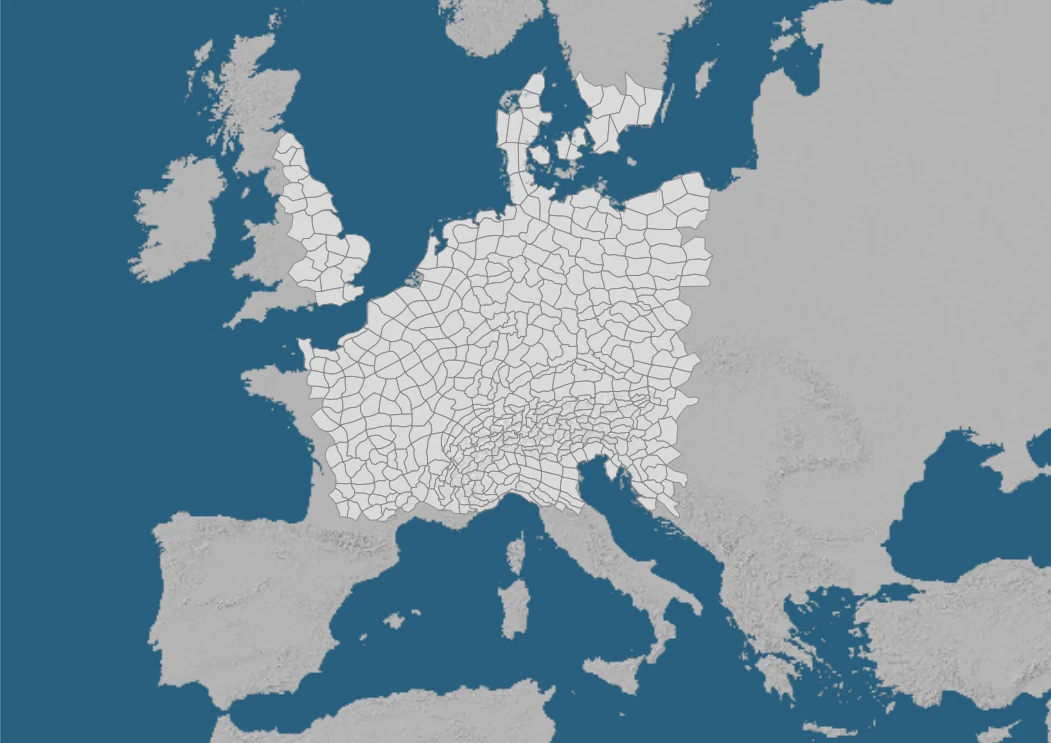
The thermal forecasts are updated up to 6 times a day. The last update of the data is always visible at the top right in the detailed forecast.
The following table lists the average publication times of the thermal forecasts. Note that these are average values and the actual publication times may vary from day to day.
Regtherm, ICON-D2 coverage
Regtherm, ICON-EU coverage
The times are in Coordinated Universal Time (UTC). If you add one hour to UTC, you get Central European Time (CET). In summer, you need to add two hours to get Central European Summer Time (CEST).
More information on the use of ICON-D2 and ICON-EU in the thermal forecast can be found here.
The division of the map into Regtherm regions is based on topographical features such as the course of mountain ranges, the height of valley floors, the volume of valleys, and the average height of the terrain.
This division based on topography is supported by scientific findings showing that convective mixing of the atmosphere mainly takes place along thermal circulation systems (slope wind, valley wind, Alpine pumping). As a result, homogeneous atmospheric conditions are found on the one hand in valleys and on the other hand in regions with similar terrain height.
In addition, the experience of local meteorologists and pilots regarding characteristic and recurring air mass boundaries can be useful for defining regions more precisely. In your home flying region, you probably know such boundaries where the strength of the thermals and the base of the cumulus clouds often change significantly. For the creation of the 1354 new regions, we interviewed numerous local pilots throughout Europe.
Your feedback is also welcome if you see potential for improvement in the boundaries or naming of a region. If you think a region has been inappropriately defined or you have a better name, don't hesitate to contact us at . This helps us to improve the forecast and the platform. Please note that we take all feedback seriously, but may not be able to address every request and suggestion for improvement.
One might think that to get even more precise forecasts, you just need to define smaller regions, down to the smallest valley in the Alps. It's not that simple, because the input data does not have the necessary spatial resolution to capture such small-scale differences. If there is no air mass difference in the input data, the Regtherm forecast will hardly be able to show a difference in thermal strength or cloud base. Therefore, the regions were only refined to the extent that the input model can still capture the topographical characteristics at its resolution. The new regions are therefore as small as necessary to capture the characteristic air mass boundaries, and as large as possible to remain clear and user-friendly.
Example:
You could define every small side valley as a thermal region so that Regtherm also models the micro-meteorological processes.
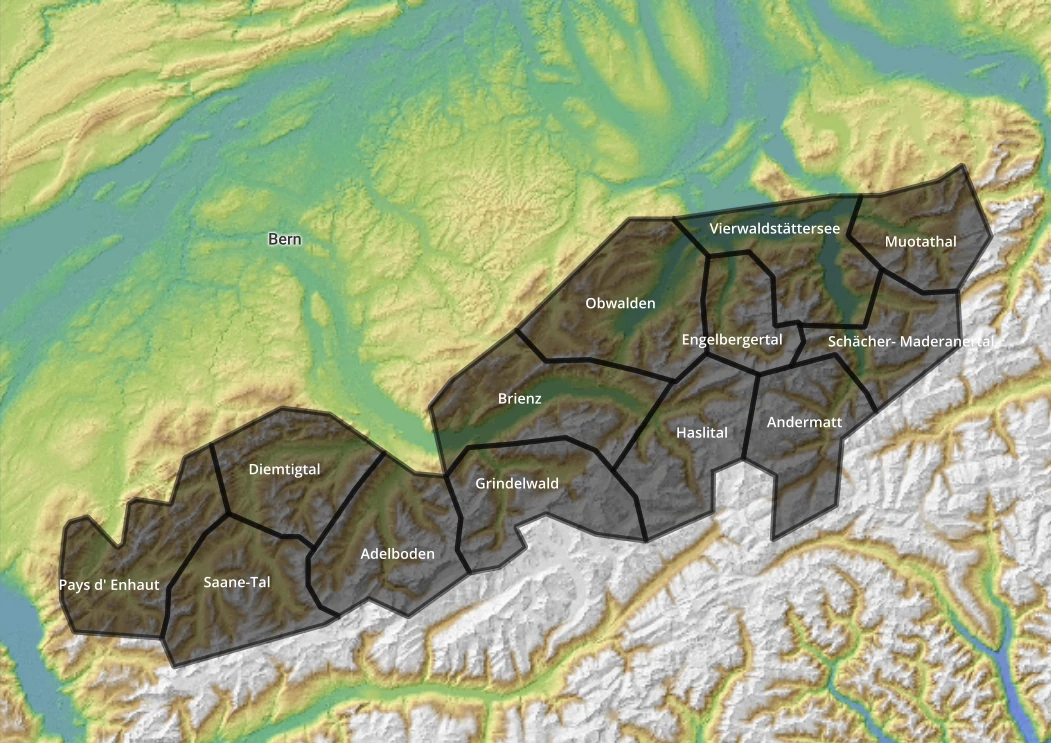
On the one hand, such a division with very small areas would lose clarity. For planning a longer flight, you would have to look at countless detailed forecasts and would get lost in the details. On the other hand, a fine-meshed division is of no use if the input model cannot resolve the topography sufficiently. The ICON-D2, with its 2.2 km grid, can still "see" most valleys, but these are greatly flattened in the ICON-D2 topography.
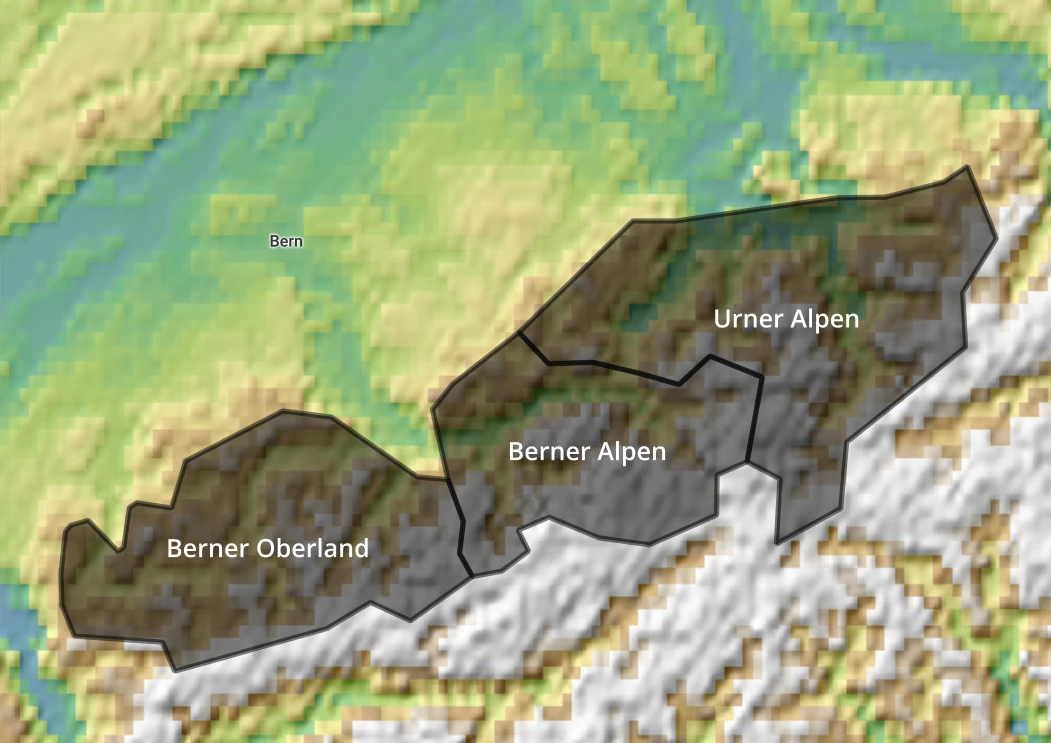
Looking at the ICON-EU topography, it becomes clear that the input model has its limits and that only the coarser division makes sense. With the new regions, the landscape is divided into homogeneous regions, with the mountain ranges separating the most important valley wind systems from each other. The ICON-EU input model also "sees" these valleys and can thus capture potential air mass differences.
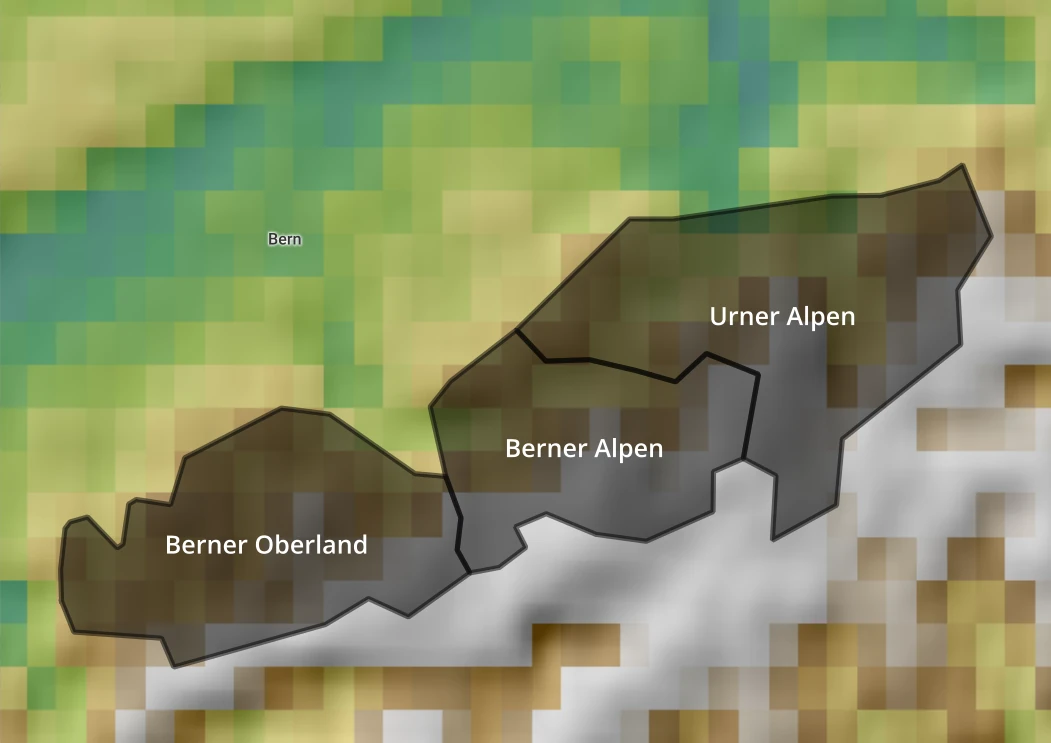
The old Regtherm regions were developed at a time when weather models had only very coarse resolution and therefore provided input data with coarse spatial resolution. These old regions were too large to capture the relevant air mass differences. The region Berner Oberland, for example, extended from Rochers-de-Naye at Lake Geneva to Pilatus in Central Switzerland, a distance of 120 km. Every pilot knows that thermal conditions and cloud base heights can vary greatly in such a large area.
Today, weather models have a better resolution and can therefore represent the real topography more precisely and provide better input data. With the new regions, Regtherm can now also capture air mass boundaries between larger valleys in the mountains and provide distinct thermal forecasts. The old region Berner Oberland has now been split into three new regions: Berner Oberland, Berner Alpen, and Urner Alpen. The new regions are as small as necessary to capture the characteristic air mass boundaries, and as large as possible to remain clear and user-friendly.
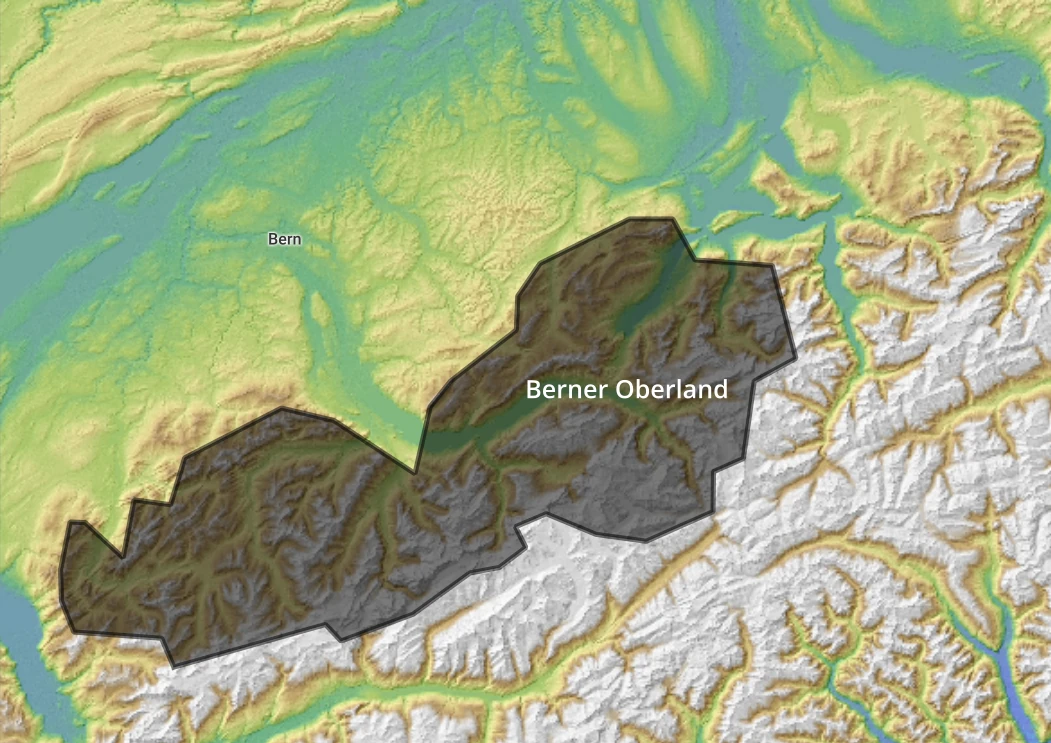
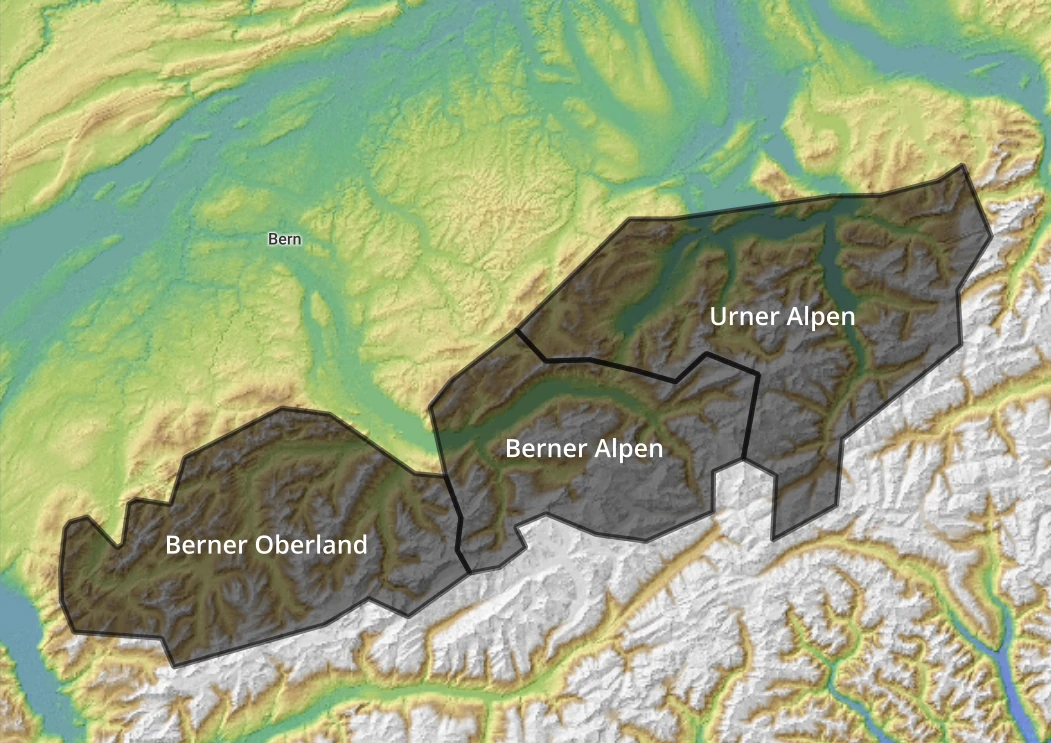
Until December 2023, the Regtherm model was calculated by the German Weather Service. XC Therm was limited to visualizing the Regtherm data, exactly the same data as shown by DWD TopTask, flugwetter.de and Alptherm (AustroControl).
In March 2024, the German Weather Service discontinued its Regtherm production and the above-mentioned services ceased. Since January 2024, XC Therm has been running the Regtherm weather model itself. Since then, the Regtherm model has been continuously further developed together with the model developer Olivier Liechti.
Numerical weather models are rather generic models that should cover as wide a range of weather phenomena as possible. However, many parameters important for a high-quality thermal forecast are not taken into account.
Regtherm, on the other hand, is a specialized thermal forecast. Regtherm is not an independent weather model, but rather relies on numerical models and calculates a forecast optimized for paragliders, hang gliders, and sailplane pilots using thermally specific parameters. In technical jargon, this is also referred to as a post-processing procedure or downstream model.
More technical details about Regtherm are explained here.
Wind and Weather Forecasts
For us thermal pilots, an accurate wind and weather forecast is essential.
The ICON model family has proven to be very reliable for wind and convection forecasts in recent years. In addition to the German Meteorological Service, Deutscher Wetterdienst (DWD), MeteoSwiss, the Swiss Federal Office of Meteorology and Climatology, has also been using the ICON models since 2024. At XC Therm, we want to offer the best wind and weather forecasts for all flying areas in Europe and especially in the Alps. The following ICON models are available at XC Therm:
The models ICON-D2 and ICON-EU from DWD (available for free even without a subscription).
The models ICON-CH1 and ICON-CH2 from MeteoSwiss (only for XC Therm subscribers).
Here you can find all important information about the models:
The ICON model is continuously developed by leading European weather services such as the German Meteorological Service, Deutscher Wetterdienst (DWD), and the Swiss Federal Office of Meteorology and Climatology, MeteoSwiss. More detailed information about the ICON model can be found here.
The resolution of a weather model is crucial for the forecast quality of wind, temperature, and cloud predictions. Especially in the Alps, where the topography is very complex, high-resolution models can represent local conditions much better.
Since March 2025, all XC Therm subscribers can also use the high-resolution forecasts of the ICON-CH1 model. The ICON-CH1 model is currently the best model for forecasting wind and convection in the Alps.
The horizontal resolution of a weather model indicates the size of the grid cells into which the model divides the atmosphere. The smaller the grid cells, the more accurately the model can represent topographical features and thus local phenomena. This leads to more precise forecasts of wind, temperature, and clouds.
The vertical resolution of a model is defined by the number of model levels. The more model levels, the more accurately the model can represent the vertical structure of the atmosphere. This is especially important for forecasting the wind profile and convection.
As thermal pilots, a precise wind forecast is particularly important to us, as we are confronted with small-scale wind phenomena such as valley winds, foehn, and lee winds in the mountains.
The forecast of foehn flows is a good example of the advantages of a high-resolution model. A high-resolution model can represent the foehn flow and its channeling through valleys and passes much better, as the valleys are depicted in their depth and structure in the model topography.
Another example is the forecast of convection. A high-resolution model can predict the location of strong updrafts and thus cloud formation much more accurately, as it can simulate regional updraft sources and air mass boundaries much more precisely.
Even with a resolution of 1 km, there are still phenomena that the model cannot represent. One example is the forecast of thermals. The characteristic size of a thermal is 30 to 100 m in diameter, which is clearly below the resolution of a weather model. As a consequence, what we cannot expect, even from high-resolution weather models, is a reliable thermal forecast. For this reason, XC Therm offers thermal forecasts from the Regtherm model, which was specially developed for thermal forecasting.
While the ICON-D2 and ICON-EU forecasts can also be used free of charge without a subscription or login, the high-resolution ICON-CH1 and ICON-CH2 forecasts are available exclusively for our subscribers.
If you have an XC Therm subscription, you have access to high-resolution wind, cloud, and precipitation forecasts for the Alps. With a resolution of 1 km (days 1-2) and 2 km (days 3-5), as well as wind forecasts at 14 different altitudes, the weather in the Alps can be assessed in more detail than ever before. Thanks to this combination, XC Therm now offers the most precise wind and weather forecasts for the Alps. More information about the high-resolution forecasts can be found here.
The wind and weather forecasts are updated up to 8 times a day. The last update of the data is always shown at the bottom right in the status bar.
The following table lists the average publication times of the different models. Please note that these are average values and the actual publication times may vary from day to day. The times are given in Coordinated Universal Time (UTC). If you add one hour to UTC, you get Central European Time (CET). In summer, you need to add two hours to get Central European Summer Time (CEST).
ICON-CH (ICON-CH1 and ICON-CH2)
ICON-DE (ICON-D2 and ICON-EU)
The atmosphere in a weather model is divided into model levels. These model levels are only parallel to the Earth's surface at high altitudes. Near the ground, they follow the terrain. Therefore, you cannot simply read the wind at a specific altitude.
The model data is interpolated to a few pressure levels and then made available to weather providers. Typically, these are the pressure levels 850 hPa (approx. 1458 m), 800 hPa (approx. 2000 m), 700 hPa (approx. 3013 m), and 500 hPa (approx. 5600 m). Most providers only show wind values at these pressure levels, which is sufficient for normal use. However, this brings two problems:
- The actual height of the pressure levels depends on air pressure. With high or low pressure, the deviation can be up to 150 meters up or down. Thus, the 3000 m forecast actually corresponds to a 2850 m - 3150 m forecast.
- The pressure levels in the range interesting for thermal pilots are too far apart. This means that important altitudes such as 2500 and 3500 m are missing for us pilots.
Some providers solve this by interpolating the 800 hPa forecast from the weighted average of the 850 hPa and 700 hPa forecasts. This, however, loses the actual vertical resolution of the weather model, as shown in the following image:
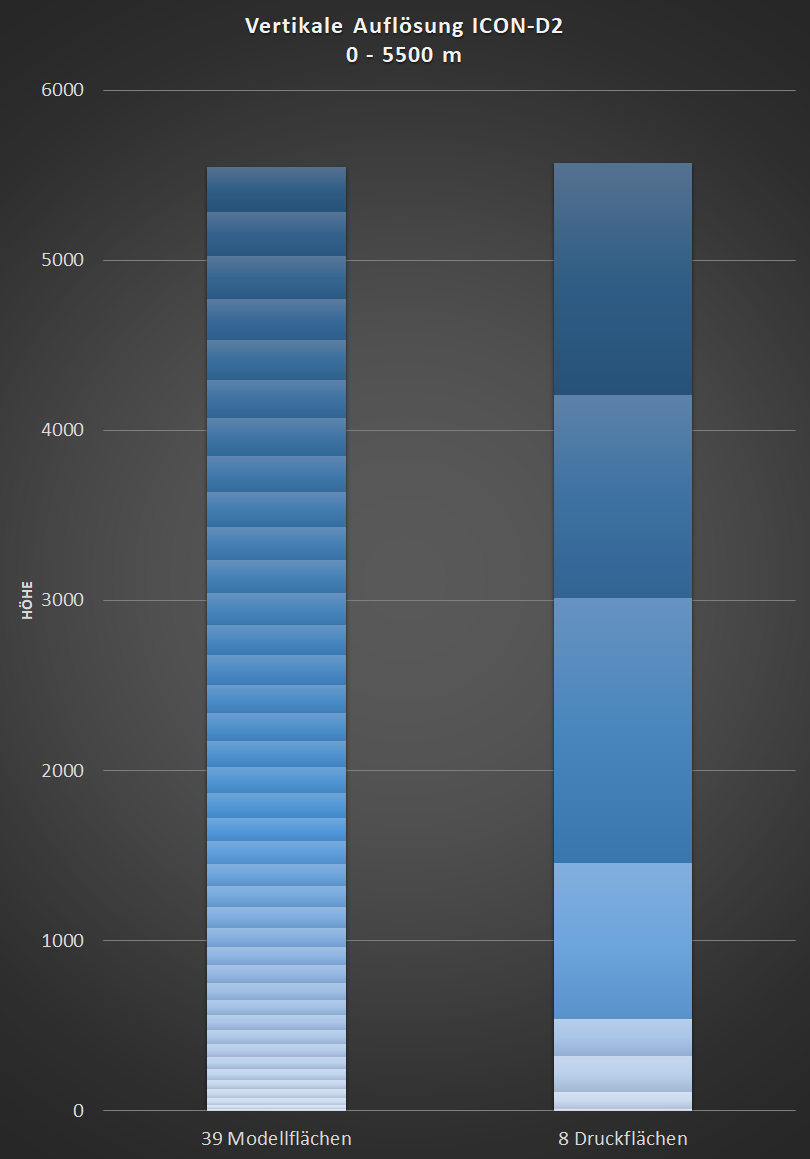
Other providers use the nearest model level for the 2500 m forecast, making it much more accurate, as the model levels at 2500 m in the lowlands are only about 150 m apart.
XC Therm goes one step further: We download the weather model data with all model levels and use the same complex calculation (interpolation) as used by the German Meteorological Service, Deutscher Wetterdienst (DWD), and the Swiss Federal Office of Meteorology and Climatology, MeteoSwiss, to calculate wind values to the exact meter of altitude. This allows us to offer highly detailed wind maps for any altitude above ground (AGL) and above sea level (AMSL). The only limitation is the computing power of our servers.
Wind gusts can indicate the strength of turbulence in the air and are therefore a useful tool for thermal pilots. XC Therm therefore visualizes the gust peaks at 10 m above ground in the wind forecast in a separate display with max 10 m.
Gust peaks at other altitudes cannot be visualized, as the weather models only output gusts at 10 m above ground as a parameter. The gust speed is the maximum expected wind speed at 10 m above ground during the following hour.
On the map, you can select between the wind forecast of the ICON-CH model family (ICON-CH1 and ICON-CH2) and the ICON-DE model family (ICON-D2 and ICON-EU) in the top menu. Depending on the model family, a different coverage area is used. The model family is shown in the time selection bar at the bottom right together with the time of the last forecast update.
Within a model family, you can distinguish between the higher resolution model (ICON-CH1 or ICON-D2) and the lower resolution model (ICON-CH2 or ICON-EU) as follows:
- Time period: ICON-CH1 and ICON-D2 forecasts are available for a maximum of 48 hours. The forecasts for the current and following day come from the higher resolution model. The days 3-5 come from the lower resolution model (ICON-CH2 or ICON-EU).
- Arrow spacing: The arrows on the wind maps correspond exactly to the model resolution. The arrows on a wind map are either 1 km (ICON-CH1) or about 2 km (ICON-CH2) apart for the ICON-CH model family. In the ICON-DE model family, the arrows are either about 2 km (ICON-D2) or about 6 km apart (ICON-EU).
XC Therm is tailored to the needs of paraglider, hang glider, and glider pilots. Therefore, there is a wind scale specifically tailored to the needs of these pilots for each category. For paragliders, for example, flying in winds over 45 km/h is usually unrealistic, which is why higher wind values are not color-coded. This makes the wind maps clearer.
The exact wind values can always be viewed by tapping or clicking on the wind arrows.
Since pressure differences always refer to the air pressure at ground level, they provide little information about the conditions at the height of the Alpine passes, especially on days with inversions. In addition, temperature at altitude and humidity also play a decisive role in whether foehn occurs. Therefore, pressure difference diagrams should be used with great caution and only as a rough indicator.
On the other hand, the wind forecasts of the high-resolution models (ICON-CH1, ICON-D2, ICON-CH2) include all the above parameters and can predict foehn flows much more reliably, especially at altitudes of 1500m, 2000m, and 2500m.
Java TopTask
TopTask is only included in the Expert subscription, which contains XC Therm with all regions. The flight simulation in Java TopTask only works properly if all regions are subscribed. For example, if there are coverage gaps, the flight path cannot be simulated meaningfully. If you have a different subscription and want to upgrade, you can find more information here.
The core functionality of the Java TopTask version offered by XC Therm is identical to the version offered by the German Meteorological Service, Deutscher Wetterdienst (DWD), until the end of March 2024. The main difference is that the new version of TopTask obtains the weather data directly from XC Therm.
As before:
- Data and model: Regtherm
- Visualizations and symbols
- Forecast variables
- Flight simulation functions
New:
- Refined regions: mainly in the Alps
- Extended coverage: all of Europe
- More frequent updates: up to 8 times daily
- Choice of base model: ICON-EU vs. ICON-D2
- No PFD ensembles
No. TopTask can only be used on a maximum of 2 computers and is bound to these computers upon first launch. Afterwards, the bindings can only be removed by support.
No. TopTask is aimed at pilots who want to plan their flights on a computer. Accordingly, the user interface is designed for large screens.
Java TopTask requires Java version 1.8 or newer.
The latest Java version can be downloaded here.
